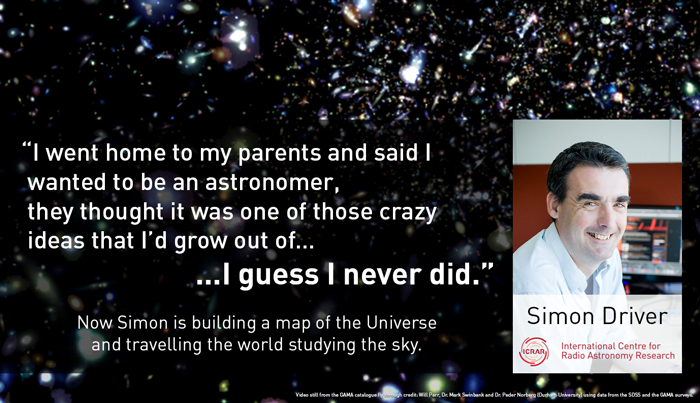Today, Professor Driver leads the Galaxy and Mass Assembly (GAMA) survey, a catalogue of 300,000 nearby galaxies and currently the largest census of galaxies in the southern skies. “It’s pretty much what it says on the wrapper, we’re trying to understand how the mass in the Universe formed into galaxies and how they have evolved since,” he said. “There’s a whole variety of science questions one can take from there but the one I’m most interested in at the moment is trying to understand the diversity of galaxies we have in the nearby Universe. We have grand design spirals, ellipticals and irregulars, some of which have internal structures such as nuclei, central bulges, discs, bars and other inexplicable features. Perhaps they’re each a marker of a different kind of formation process —a spherical bulge might be an indicator of galaxies grown by merging, a disk might be an indicator of gas falling in etc.”
Professor Driver said GAMA was gathering information on multiple telescopes and at all wavelengths. “We have time allocated on three ground-based optical telescopes, two radio arrays and three space missions which together are surveying the same regions of sky from ultraviolet to radio wavelengths,” he said. “To some extent we’ve been stalled on trying to understand galaxy formation for 80 years and one of the reasons for that is that astronomers tend to be quite myopic, working in one wavelength range for their entire careers. The problem is that galaxies are so complicated, you’ve got hot and cold gas, dust, stars and dark matter and it’s the interplay of these components that leads to galaxy evolution. To look at that you have to look across the full wavelength range and that’s never been done on such a large scale until now.”
The Galaxy and Mass Assembly catalogue is a project to create a detailed map of the Universe showing where galaxies are in 3D that’s led by Professor Driver.
This simulated flythrough video shows the real positions and images of the galaxies that have been mapped so far. Distances are to scale, but the galaxy images have been enlarged for your viewing pleasure.
Credit: Video made by Will Parr, Dr. Mark Swinbank and Dr. Peder Norberg (Durham University) using data from the SDSS and the GAMA surveys. This work was supported by the Ogden Trust, STFC and the Royal Society. More videos of the GAMA catalogue are available at http://astro.dur.ac.uk/~ams/GamaMovie/index.html.
